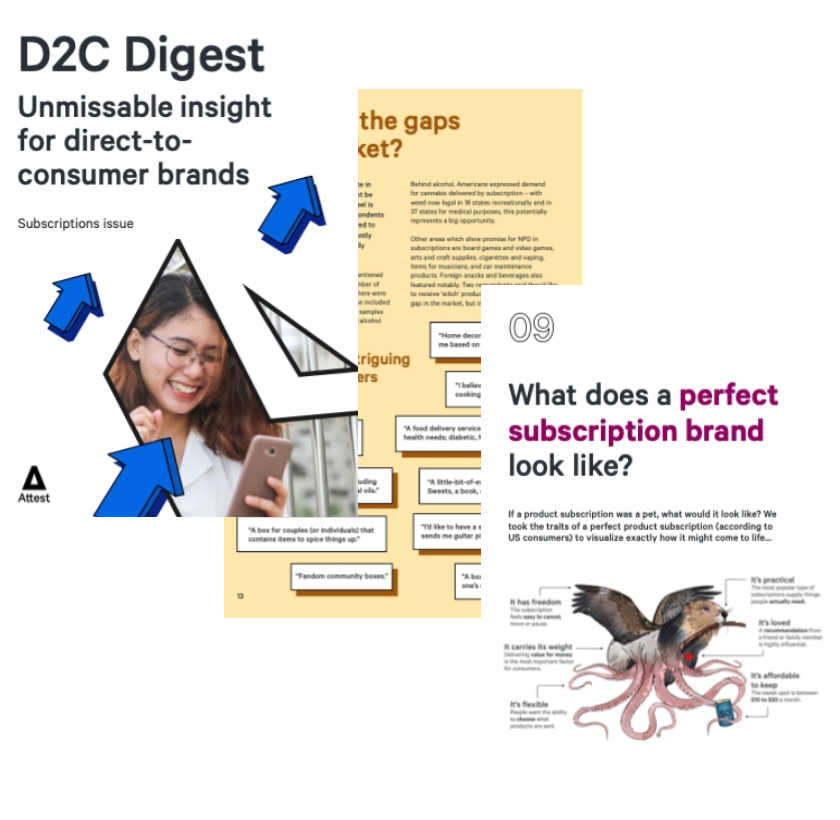What Americans want from product subscriptions in 2022
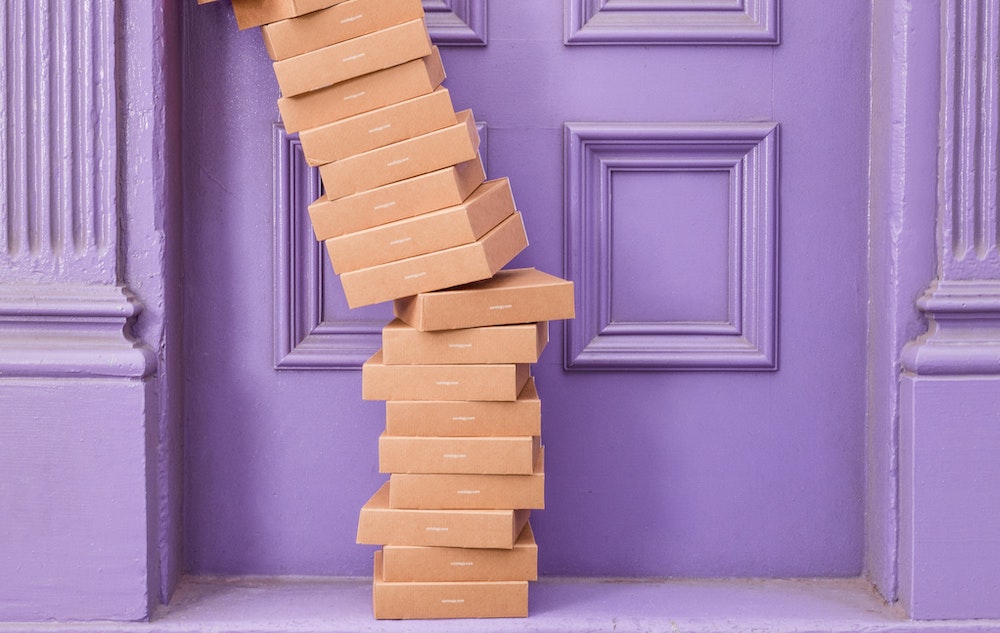
65% of Americans say they’re open minded to purchasing a product subscription, but what is it that will convince them to commit?
Would you like cannabis or witchcraft products delivered directly to your door? These are just a couple of the gaps in the market for product subscriptions, according to American consumers.
In our survey of 2,000 working age US consumers, we found that 65% of respondents are open minded to purchasing a new product subscription (read the report), and we wanted to dig into exactly what would interest them.
Aside from the quirky ideas (more on those later), we found practical product subscriptions that replenish the things people run out of are still the most popular type (no change since we last asked in November 2020).
The second most attractive type of product subscription is one that provides inspiration and encourages people to try something new, while indulgent product subscriptions are the least popular type. This could be a reflection of the drop in consumer confidence attributed to rising COVID-19 cases.
It’s worth noting, though, that Gen Z (aged 18-25) show the most interest in product subscriptions that offer ‘treats’; 30% ranked indulgent subscriptions first.
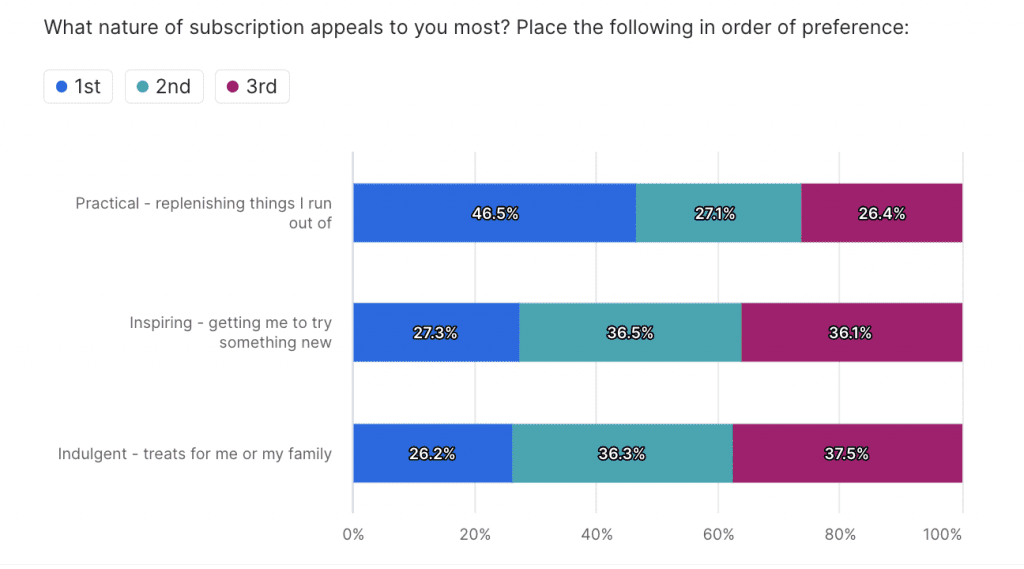
How much are people willing to spend?
Americans are most likely to say they would pay between $10 to $20 a month for a new subscription (30% selected this answer). A further 22% would pay $21 to $30 per month, while 12% would be prepared to pay $31 to $40 and 11% would shell out $41 to $50.
Only 13% would purchase a product subscription that costs in excess of $50 per month. At the other end of the scale, 12% expect to pay less than $10.
Boomers are the demographic prepared to pay the most, while Gen Z want to pay the least.
Boomers (aged 56-66) are the demographic prepared to pay the most, over-indexing for the higher price points (24% will pay $21 to $30, 15% will pay $31 to $40 and 12% will pay $41 to $50).
Gen Z generally want to pay the least (35% will pay $10 to $20), although they do over-index for willingness to pay $51 to $60 (6%). For the most part, Americans thinking about purchasing a new product subscription will expect to pay no more than $30 per month.
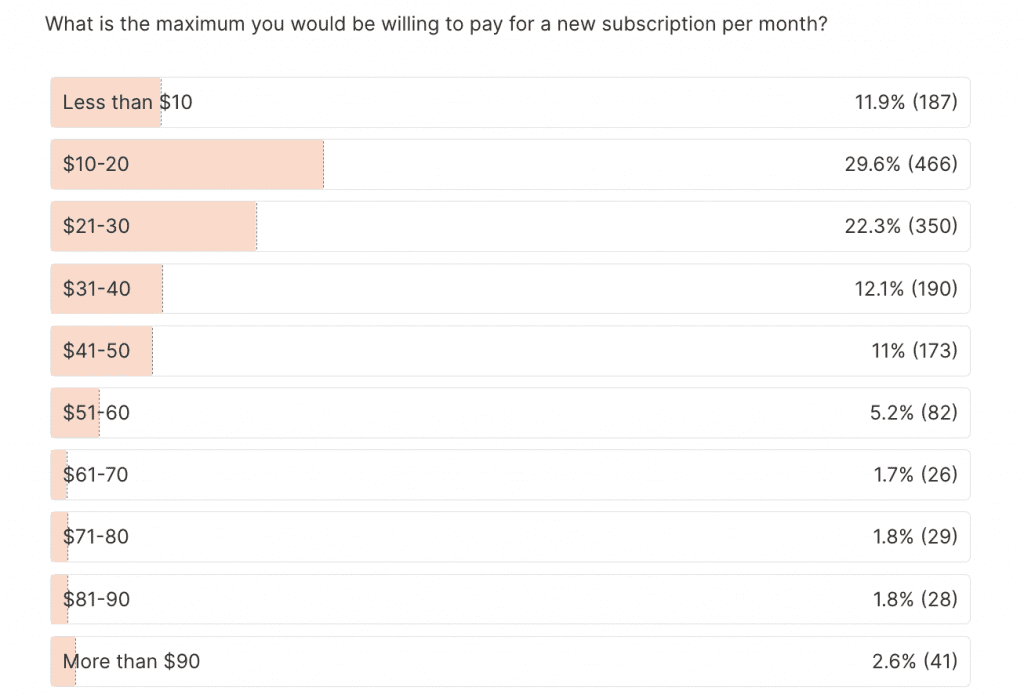
What categories enjoy the most consideration?
Food and drink is the leading category Americans would consider for a new subscription; 51% are interested in food or drink products. This interest is reflected across all demographics, with the strongest demand seen among Gen Z (55%).
Personal care and health/fitness is second most popular, with 44% interested in a subscription in this category, while clothing and shoes is third (39%). Younger consumers show stronger interest in clothing and shoes subscriptions than older shoppers; 48% of Millennials and 47% of Gen Z say they’re interested versus just 20% of Boomers and 36% of Gen X (aged 41-55).
41.5% of Gen X say they’re interested in pet product subscription boxes.
Pet products come in fourth overall, with the strongest demand seen among Gen X (aged 41-55); 41.5% of this demographic say pet subscriptions are of interest, while 37% of Boomers agree. Toiletries and cosmetics take fifth place (36%), but Millennials (aged 26-40) are keenest on this category, with 40% interested.
Subscriptions relating to hobbies such as reading or gardening are sixth most popular (35.5%), bags and jewelry is seventh (20%) and kids’ interest rounds out the categories, with 19% considering a subscription. However, Millennials and Gen Z show significantly more interest in hobby boxes and bags and jewelry subscriptions than their older counterparts. Millennials also over-index for being interested in kids’ interest subscriptions (30%).
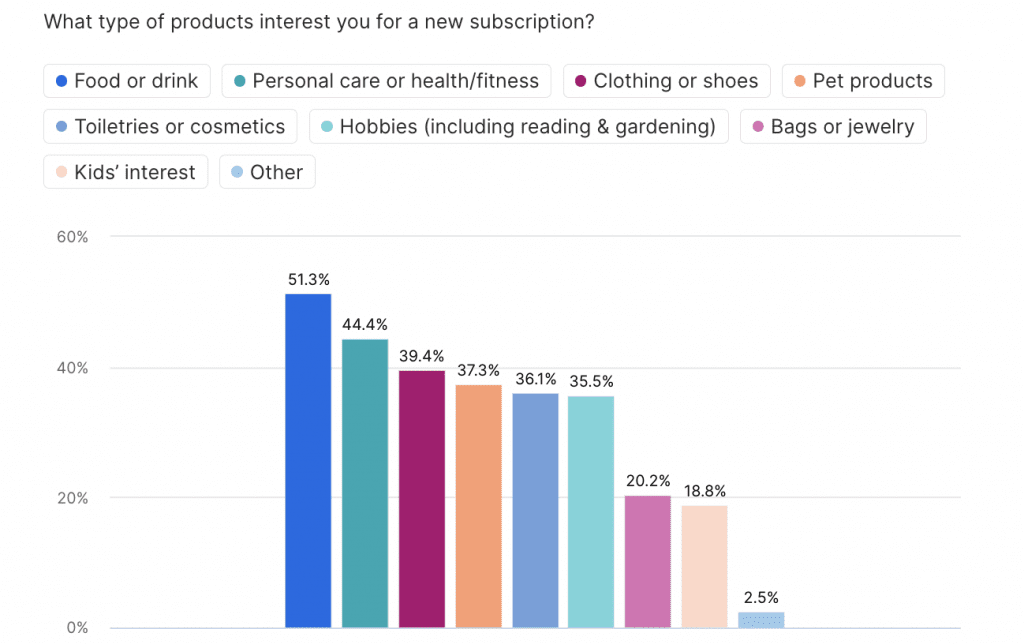
Where are the gaps in the market?
If you’re a business looking to innovate in the subscription space, you’ll no doubt be interested to know what Americans feel is missing in the market. We asked respondents what they would like regularly delivered to their door that they don’t feel is currently available – and we received some really interesting feedback.
The number one item most likely to be mentioned was alcohol. And while there are a fair number of subscription boxes catering to drinkers, there were some ideas for more niche offerings. These included alcohol and cigar boxes, boxes with small samples of beers and spirits and boxes that mixed alcohol with cosmetics and lingerie.
Behind alcohol, Americans expressed demand for cannabis delivered by subscription – with weed now legal in 18 states recreationally and in 37 states for medical purposes, this potentially represents a big opportunity.
Other areas which show promise for NPD in subscriptions are board games and video games, arts and craft supplies, cigarettes and vaping, items for musicians, and car maintenance products. Foreign snacks and beverages also featured notably. Two respondents said they’d like to receive ‘witch’ products – maybe not a huge gap in the market, but interesting nonetheless!
Here are other intriguing ideas US consumers came up with…
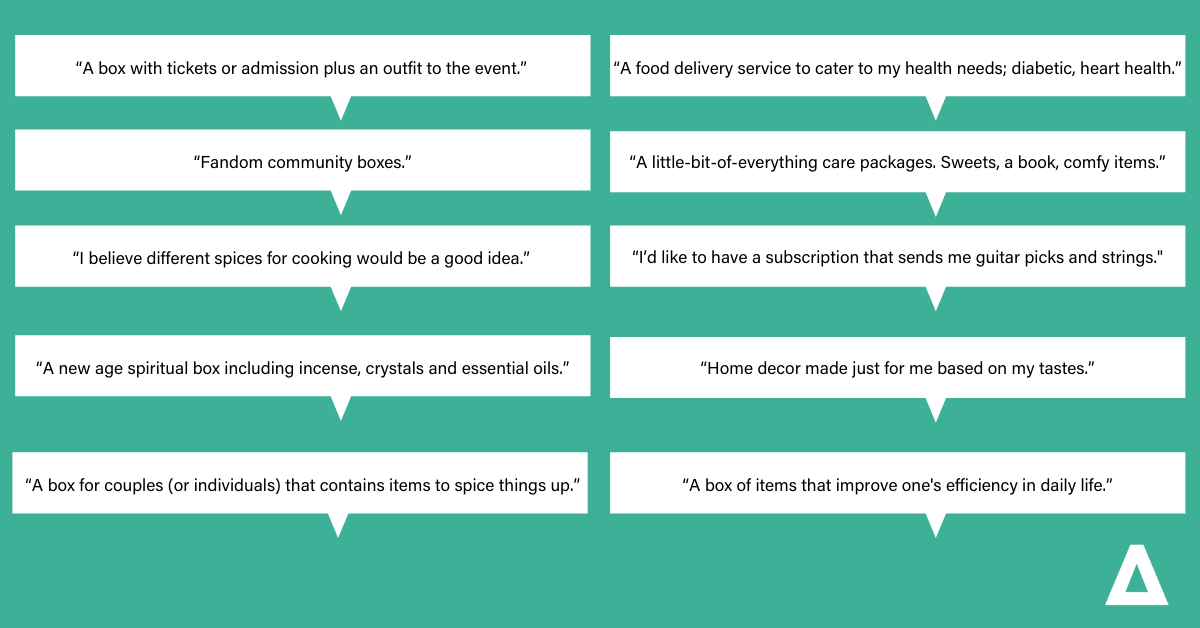
What factors will make folk sign up?
Besides offering a product that people actually want, how can you make your subscription proposition appealing? And looking at it from the other direction – how can you make sure there’s nothing about it that’s off-putting?
We asked Americans what factors are important to them when thinking about purchasing a product subscription and found that there’s one thing that’s more important than all the rest – value for money.
Nearly 7 in 10 consumers say a product subscription must offer value for money, and we see that value sensitivity increases with age (77% of Boomers are focused on value versus 56% of Gen Z).
The second most important factor is that the subscription offers the ability for customers to choose what products are sent (54% of people say this) and, again, it’s more important the older you are.
Value for money is the most important factor for Americans considering a subscription brand.
It’s nearly as important that the subscription can be easily paused or canceled (53% of people expect this), although Millennials are less bothered than other demographics (47% say it’s important versus 54% of Gen Z, for example).
The fourth most important factor is that the subscription brand gets great reviews (39% say this). And it’s especially important to Gen Z; 53% of this demographic look for great reviews, while only 30% of Boomers do the same.
Offering exclusive products that are not available elsewhere is important to 34% of shoppers, with Gen Z most motivated by this (38%).
Now let’s look at the three least important factors for people weighing up product subscriptions… this might come as a surprise, but only a quarter of consumers are driven by the brand having a strong purpose or ethos. With that said, it’s more of a motivating factor for the youngest consumers; 35% of Gen Z state purpose is important to them versus 26% of Millennials, indicating that conscious consumerism will be driven by the new generation.
35% of Gen Z say a subscription brand must have a strong purpose or ethos.
Meanwhile, ‘unboxing’ is a phenomenon of the social media age and lots of D2C brands have focused on nailing great packaging and presentation, yet only 21% of Americans state this is important to them. Boomers are really not bothered about the aesthetics of their product subscriptions (only 9% says it’s important), but we do see this factor carries more weight among younger demographics. 34% of Gen Z are looking for Instagrammable moments when it comes to the packaging and presentation of their subscriptions.
Finally, the least important factor when assessing subscription offerings is that it’s popular. Only 16% of people say popularity is important, although what people say and what people do are two different things. We know that subscriptions that attain ‘must-have’ status are likely to enjoy snowballing sales. Gen Z are most likely to agree that their purchasing behavior is influenced by what’s trending; 26.5% say a subscription’s popularity is important.

What type of advertising works best?
The power of personal recommendation cannot be overstated; our research finds that a recommendation from a friend or family member is far and away the most influential factor that pushes someone to consider a subscription box brand.
While it lags way behind receiving a recommendation, ‘seeing an advert’ comes in second (which is reassuring for those allocating advertising budget). The third most influential factor is seeing a product subscription talked about on social media, again demonstrating the importance of social proof.
Younger consumers are influenced more strongly by social media.
Traditional PR is also effective, with ‘seeing a product subscription featured in the news’ in a close fourth place. Coming in last in terms of perceived influence, is an influencer or blogger talking about the brand.
There are some interesting differences between the demographics, which should be taken into consideration when trying to reach these audiences. Gen Z and Millennials rank social media second and advertising third, while Gen X place ads second and news features third. Boomers, on the other hand, put news features second and ads third. Younger consumers are also more likely to rank influencers and bloggers higher than their older counterparts.
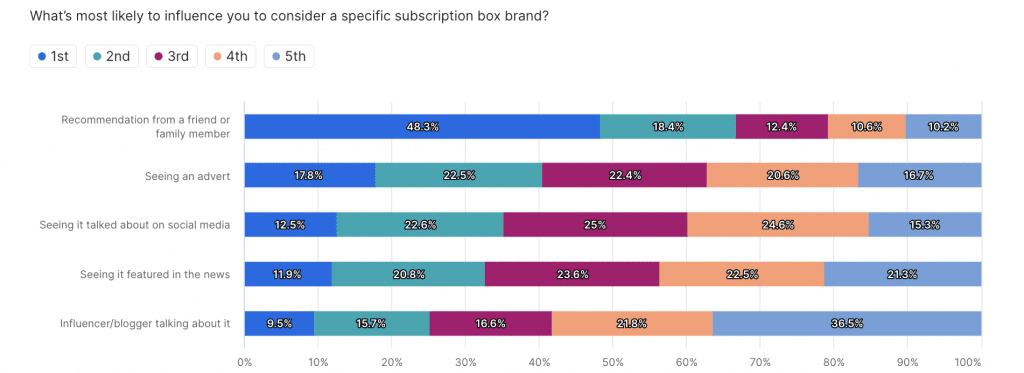
Which subscription box brands enjoy most share-of-mind?
Now we know how Americans discover and appraise product subscription brands, let’s see which ones are doing the best job of making an impression. We asked respondents to name brands in three categories; food & drink, health & beauty and clothing & accessories.
There are two brands leading the F&B category; Hello Fresh and Blue Apron, although Hello Fresh was named by nearly twice as many respondents as Blue Apron.
Stitch Fix has the most unprompted brand awareness of US subscription boxes.
The health & beauty category is strongly dominated by Ipsy and, although Birchbox is next most likely to be named, it has far lower unprompted brand awareness. Meanwhile, Stitch Fix has massively monopolised share-of-mind in the clothing & accessories category. Stitch Fix was also the subscription brand most likely to be mentioned overall.
With such dominant incumbents, it appears to be difficult for newcomers to make a name. As such, it makes sense for subscription startups to carve a niche for themselves rather than trying to compete with the big boys. We’ve already seen some of the more specialised types of product subscriptions American consumers are interested in – and it’s catering to these needs that represents the biggest opportunity.
Want to find out more about D2C consumer trends?
Download our direct-to-consumer report for the latest industry insights or get D2C content delivered straight to your inbox.
Tell us what you think of this article by leaving a comment on LinkedIn.
Or share it on:

